I want to put a tag of shame on the greedy bastards who are responsible for this [the Great Depression and its effects].
https://www.greenleft.org.au/content/long-retreat-john-steinbeck
This following article is a story about a novelist, a director, an actor, a folk singer, the United States Government and a character named "Tom Joad"!
IT STARTED ON OCTOBER 24, 1929, OR DID IT?
It was on October 24, 1929 that the United States Stock Market crashed and sent waves across the world. The attitude of America's overly wealthy are reflected, according to Charles Schultz's 1999 article for the University of Wisconsin-Madison, in the words of John D. Rockefeller at time:
These are days when many are discouraged. In the 93 years of my life, depressions have come and gone. Prosperity has always returned and will again.
Economists argued at the time and still today as to whether the "Stock Market Crash" was the cause, or just a symptom of "The Great Depression". My opening quote from John Steinbeck seems to imply, for the author, that it was only a symptom and that those "Greedy Bastards" were at fault.
The New York Stock Market started to fall on September 4, 1929. Which was a full 51 days prior to "Black Tuesday" and the Federal Government would do nothing to stop the direction the market started going. Claiming they believed it would recover within a few days of September 4th.
The President of the United States was Republican Herbert Clark Hoover, who had not been the first choice of many of the Republican Party leaders, and was sworn into office on March 4, 1929. Following the eight years of Republican President Calvin Coolidge's administration.
Hoover had made several grand promises to the American Voter, but that wasn't the real reason for his win. The Democratic candidate, Al Smith, was in fact that the more charismatic of the two men, but was "Catholic" and Americans were fearful of the "Pope's Control" over a President Smith. So, the die was cast for what was to come!
.
Above President Hoover addresses the country during the start of "The Great Depression".
Shortly after his inauguration President Hoover had told America that:
given the chance to go forward with the policies of the last eight years, we shall soon with the help of God, be in sight of the day when poverty will be banished from this nationBelieving in President Hoover, Americans looked forward to greater prosperity. Hoover wanted to get business and labor to the bargaining table and end what is still known as the "Business Cycle". Which is the downward and upward movement of the gross domestic product (GDP) around a long-term growth trend. This looked fine on paper, but Hoover overlooked obvious factors at the time. As the bullish Stock Market kept climbing higher and higher, since March 4, 1929, and he considered it the measure of the United States economy.
Those overlooked factors were:
A sustained Farm crisis
A saturation of Consumer Goods that were being made, but not being purchased
A growing Income inequality between the John D. Rockefeller's and the average American worker
A problematic International financial situation
A weak enforcement of anti-trust laws causing a consolidation of Businesses
The Start of the Great Depression
As to the Stock Market, there had major speculation occurring created by the end of the "Roaring 20's Boom". Which needed to be brought under control, but President Hoover did not want to become involved with the "Federal Reserve System" directly and left it alone to find its own way. This would directly lead to the crash.
"The Currency Act of 1900" did more damage than good. It lowered the minimal standard of capital from $50,000 to $25,000 to start a bank and this resulted in thousands of local banks being created. The actual number of banks in the United States doubled due to the lack of oversight by the Federal Government by 1920 from prior to the act and was continuing to grow.
The Stock Market crash was followed, between 1930 and 1931, by a series of regional banking panics that should have been controlled by the "Federal Reserve", but weren't. Local States, starting with Nevada, declared "Bank Holidays" to attempt to stop banks from going under and of course this did not work. Additionally, this all created an "International Financial Banking" crisis between 1931 and 1933 that impacted on what Hoover and the Federal Reserve should have done.
The existing "Farm Crisis" should have been a major concern of President Hoover. It had actually started in 1921, under Republican President Warren G. Hardening, and was a sign, also ignored by President Coolidge, of those small banks not having the funds needed to actually operate. Farmers were loosing crops of corn and cotton and there was no Federal Bail-out money to help them. Slowly, but the signs were there since 1921, "Family Farms" were going under and the dust bowl areas of the United States were developing.
All these factors were coming together, no matter what John D. Rockerfeller believed, as "The Great Depression". Panic began to spread across the country as banks, even those being robbed by the likes of Bonnie and Clyde and John Dillinger, were broke. President Herbert Hoover felt it was not the Federal Governments responsibility to bail out the States and wanted the Governors to handle their individual problems. While the United States Congress, divided upon Party Lines, couldn't come together on any major assistance.
Across the country "Hoovervilles", cardboard houses on vacant lots, started to appear. The name came from Charles Michelson, the publicity chief for the "Democratic National Committee", putting the blame on what was now "The Great Depression" directly upon President Herbert Clark Hoover.
Above a "Hooverville" in Houston, Texas, and below a "Hooverville" in Portland, Oregon.
JOHN STEINBECK
Above John Steinbeck in 1939 at the time of the publication of his "Pulitzer Prize Winning Novel" "The Grapes of Wrath".
John Steinbeck was born on February 27, 1902 in Salinas, California. 
Above is that house John Steinbeck was born in and is now a museum and restaurant for tourists.
Central California's Salinas Valley is one of the most productive agriculture areas in the State and was one of the major destinations of the migrant farmers during the 1930's. 
After the 1935 publication of "Tortilla Flat", John Steinbeck decided to write about "Dust Bowl America" and what was to have been one novel eventually became a trilogy.
The first was published in 1936 about a Union organizer attempting to get better wages and working conditions.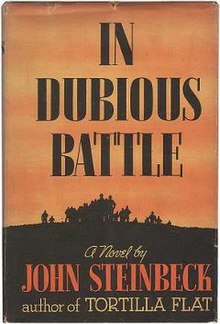
The second was known for a stage play version and the two motion pictures, to date, about migrant workers "George" and "Lennie".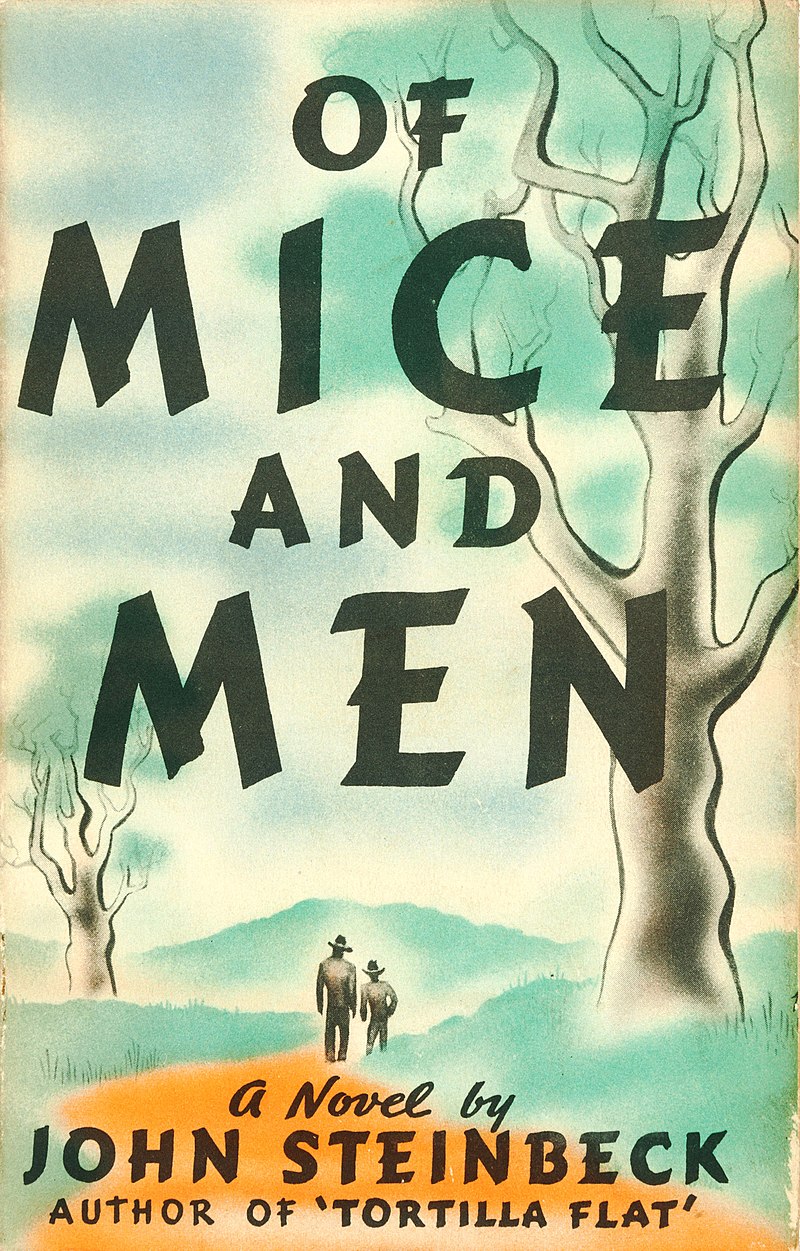
The third wasn't published the year following "Of Mice and Men", but instead a group of short stories and a non-fiction work came out in 1938. It would be 1939, when the third novel about a migrant family, the "Joad's", and their journey across America to the promised land of California was released.
There are six main characters in 'THE GRAPES OF WRATH":
Tom Joad is the protagonist of the story and the second "Joad" son. In many ways he become's John Steinbeck's "Every Man".
Ma Joad is the matriarch of the family and their strength.
Pa Joad is the patriarch and his first name is also "Tom". He is a proud sharecropper, but the Depression causes him to loose his livelihood and he becomes a broken man.
Uncle John is "Pa's" older brother. He blames himself for the death of his young wife years before and goes on alcoholic binges and seeks solace with prostitutes. However, he is generous with sharing anything he has with others.
Jim Casy is a former preacher who has lost his faith. John Steinbeck makes him a "Christ-like" character and based "Casy" on his own friend Edward Flanders Robb Ricketts. Ricketts was a marine biologist, ecologist and philosopher.

Above Edward Ricketts in 1937.
Rose of Sharon Joad Rivers is the oldest "Joad Daughter" and is a childish and dream girl of 18.Who over the story will develops into a strong woman.
In all their are 20 characters of importance in the Steinbeck novel and 11 of them have a last name of "Joad".
The novel opens on the day "Tom Joad" is paroled from "The Oklahoma State Prison" in McAlester, for killing a man in self-defense. 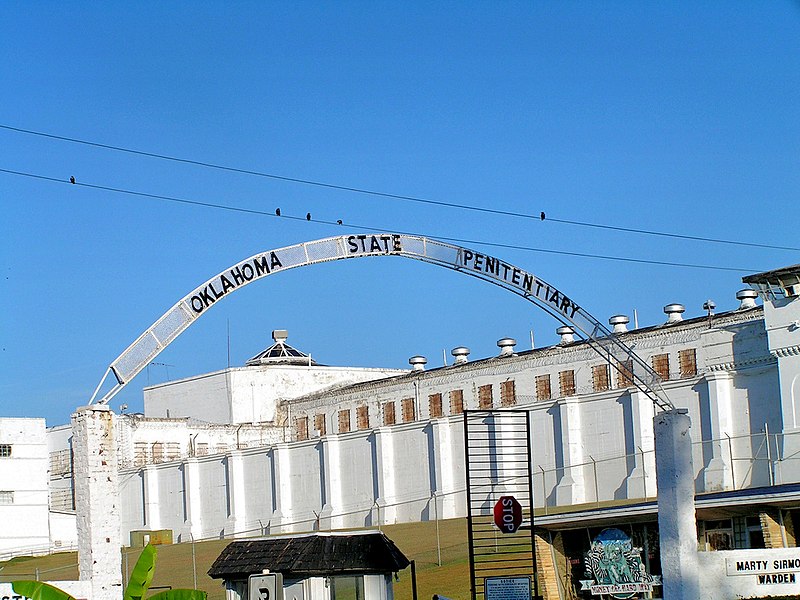
"Tom" starts hitchhiking toward his home in Sallisaw, Oklahoma, the county seat of Sequoyah County.
The above photo of Sallisaw was taken during the early 1930's. Below is the main street in Sallisaw in 1936. 
As "Tom Joad" continues to hitchhike home, he meets the former preacher "Jim Casy". "Tom" remembers "Jim" from his youth and the two travel together. Upon arriving at "Tom's" childhood farm home, they find it is deserted and this confuses him.
"Tom" and "Jim" find the "Joad's" old neighbor "Muley Graves" and learn that "The Banks" have evicted all the farmers for non-payment of their mortgages, or rents. However, "Tom's" family has moved in with his "Uncle John Joad" and the entire family is refusing to leave the place.
Arriving the next day at "Uncle John's". "Tom" and "Jim" find the entire family packing an old Hudson sedan, they have converted into a truck, to leave Oklahoma for the promised land of central California. Their action, like many others in Oklahoma and other States, was the result of the "Dust Bowl" destroying the crops and even "Uncle John Joad" having been forced, by those weather conditions, to default on his bank loans. The bank finally repossessed the farm and "Uncle John's" time to remain on the farm has run out. "Tom", reunited with his family, and "Jim", join the group.

Above a "Dust Bowl" family living out of a converted sedan turned into a truck.
Now the "Journey of the Joad's" begins down "Route 66" and John Steinbeck turns them into his "Every American Farm Family".
The following are a few photographs taken along "Route 66" by photographer Dorthea Lange. While she was working for the "Farm Security Administration (FSA)" under President Franklin Delano Roosevelt.

Above Dorthea Lange and below her photo just entitled "Migrant Mother!".
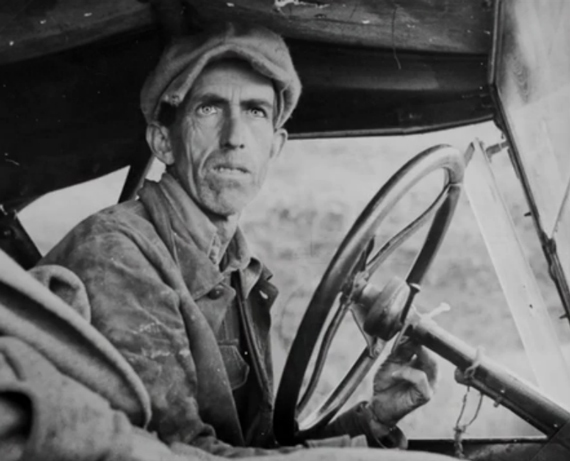
As the family travels "Route 66" they hear stories, by passer-by's, about how great California is going to be, but also stories from families returning from California with the opposite point of view. Tragedy hits the family, as first "Grampa Joad" dies and they bury him beside the road in a field. Then, "Grandma Joad" dies within site of California and the oldest "Joad son, Noah", decides to leave the family to make it on his own. Which is soon followed by "Connie Rivers", the husband of the oldest and now pregnant "Joad daughter Rose of Sharon", doing the same as "Noah" and leaving the family and her. "Ma Joad" has become the families leader and they cross the Arizona State Line into California.
The family had first stopped at a local "Hooverville". There, they see a Sheriff aiming to shoot at a migrant worker running away from him and the local grower's labor recruiter he's with. Apparently, that migrant worker was familiar with the recruiter and had alerted the new arrivals that he is known for not paying his promised wages. Seeing this attempt to shoot an unarmed man. Will cause "Jim Casy" to knock the Sheriff down and as a results gets himself into trouble with the Deputy.
It is at the "Hooverville" that the "Joad Family" discover the truth of the words of those who have left California. The farm areas are overcrowded with laborers and wages are lower than expected. Those who are able to find work are exploited by cruel Farmer Growers and overseers to the point of starvation, because their wages will not cover what is owed "The Farm Store" for food and clothing. Additionally, as already noted, the local Sheriff's are on the pay of the growers and appear just as cruel toward migrant farm hands as the growers paid guards.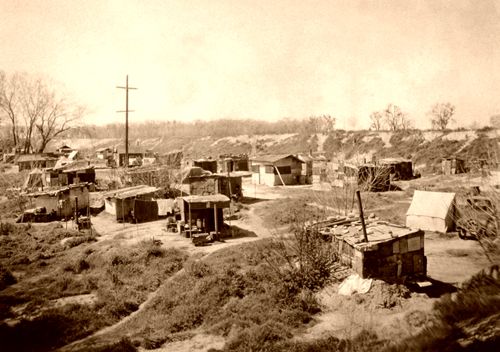
Above is a "Hooverville" near the State Capital of Sacramento, California.
Next the remaining members of the "Joad" family and "Jim Casy" arrive at the real "Weedpatch Camp". The camp was also known as "Arvin Federal Government Camp" and the "Sunset Labor Camp". It was located just south of Bakersfield, California and was built in 1936. This was one of the cleanest camps in the country.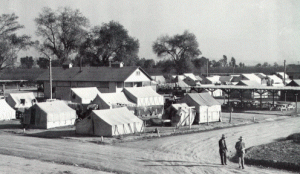
Above is a Dorthea Lang photograph of the camp. Below the Post Office and Library. 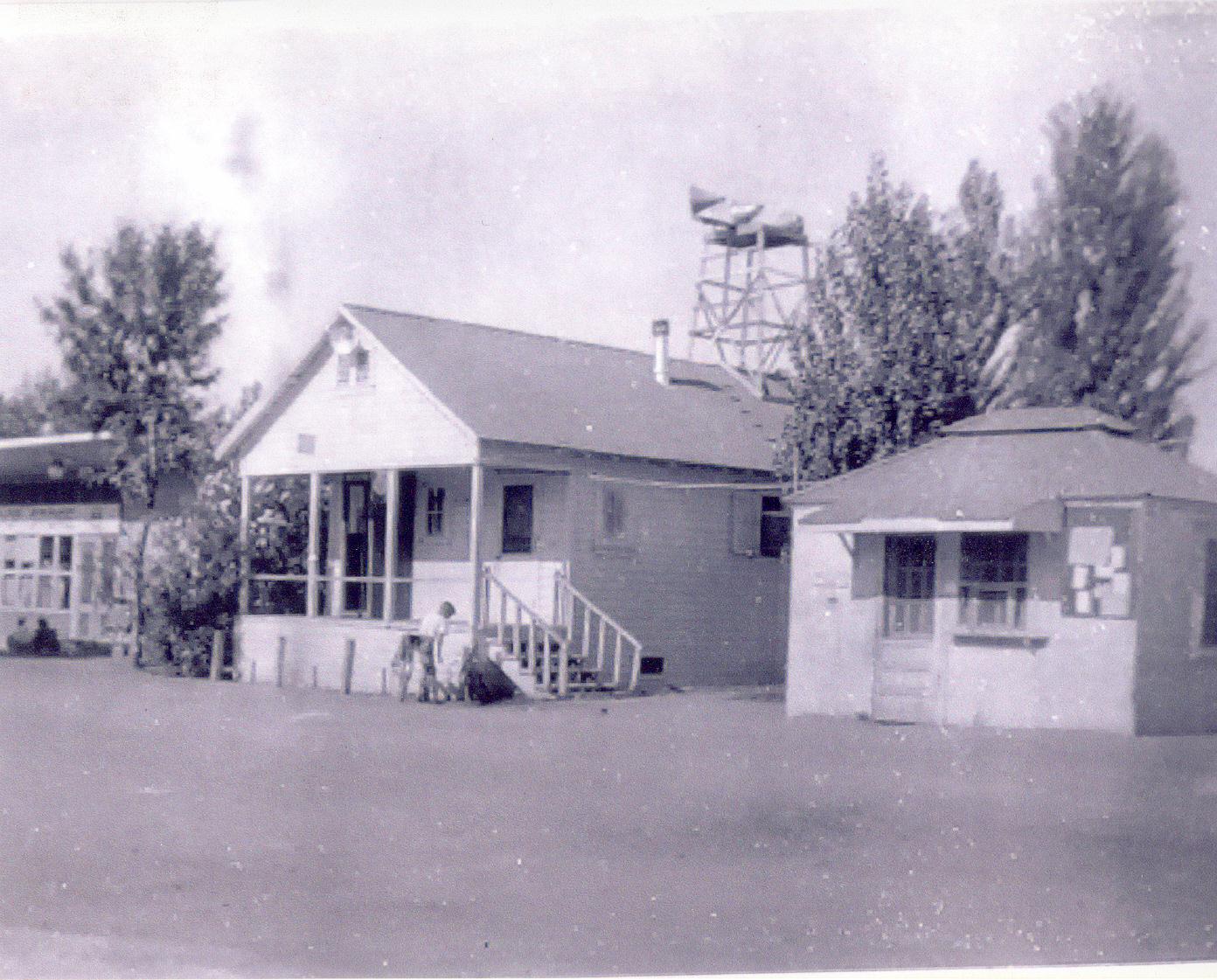


The camp was part of FDR's "New Deal" "Resettlement Administration (RA)".
The problem the "Joad's" find is that although "Weedpatch Camp" protects the migrant workers from harassment by local Sheriff Deputies working for the large California Growers. The camp is overcrowded and doesn't have enough resources to provide for all the families. Additionally, the camp does not supply food, or work.
"Jim Casy" becomes a "Union Organizer" and attempts to organize the migrant workers at "Weedpatch Camp". Thus taking on the wrath of the growers and the deputies.
One morning the local Peach Grower, and the main source of income for the migrant workers, announces that the pay rate for picking his peaches has been reduced to half of what it was the day before. "Jim Casy" leads a strike that turns violent and "Tom" witnesses "Jim's" fatal beating and goes for "Casy's" attacker killing him. In the confusion of the moment, "Tom" is able to leave the scene unnoticed.
The "Joad's" leave "Weedpatch Camp" and head for a cotton farm in another part of the State. On their way the family meets "Tom" who had been hiding along the road. Below, a Dorthea Lang photo, of a cotton picker on a San Joaquin Valley cotton farm in 1936.

Below a Fresno, California cotton field.

Knowing he must leave the area, or face being arrested and his remaining family being "Blacklisted" from working the fields. "Tom Joad", John Steinbeck's "Every Man", bids his mother good-bye and vows to work for the oppressed.
As John Steinbeck wrote:
How can you frighten a man whose hunger is not only in his own cramped stomach but in the wretched bellies of his children? You can't scare him – he has known a fear beyond every other.The rest of the "Joad" family under "Ma Joad's" leadership continue to pick cotton and pool their wages to buy food. Sadly, "Rose of Sharon's" baby is stillborn, because of her malnutrition. "Ma Joad" remains steadfast and brings her family through their bereavement over the baby's death'. The California cold winter rains come and the families house is flooded and the truck disabled. "Ma Joad" leads her remaining family to higher ground and shelter in a barn. Inside the barn they find a young boy and his father dying from starvation. "Ma" looks toward "Rose of Sharon", who understands what her mother wants her to do. The "Joad" family leave the barn except "Rose of Sharon". She goes to the man and offers him her breast milk. So ends John Steinbeck's novel.
The months following the publication led to a strange coming together in the motion picture industry and a consideration of the politics of the writer.
THE GRAPES OF WRATH released January 24, 1940
.jpg)
Politics of the Author:
John Steinbeck's views were contrary to most Republicans at the time of writing "In Dubious Battle". The novel was a defense of migrant farm workers and depicted a major strike that was backed by "The Party". Some things go well for the farm's workers and some things go very wrong. Most conservative minds felt that "The Party", never mentioned as anything else, was the "Communist Party USA (CPUSA)" that was involved with the Labor movement at the time.
John Steinbeck went onto J. Edward Hoover's radar as a result of his trilogies first novel.
Hoover had FBI Agents looking into investigating the author as either of a member of the "CPUSA", or a sympathizer. Because he was also a member of the "League of American Writers". An organization that had among its progressive members, considered by Hoover as potential Communists, Lillian Hellman, Dashiell Hammett, Arthur Miller and Upton Sinclair.
By the time of the publication of "The Grapes of Wrath". J. Edgar Hoover gave up on attempting to turn John Steinbeck into a Communist, but started further "Government Harassment". By using the power of the "Internal Revenue Service (IRS)" to take over harassing the author.
Two years after John Ford's motion picture, John Steinbeck wrote a letter to "United States Attorney General Francis Biddle" asking:
Do you suppose you could ask Edgar's boys to stop stepping on my heels? They think I am an enemy alien. It is getting tiresome.
Politics of Two Motion Picture Makers
In an article looking back on the motion picture, Film Critic Roger Ebert, "Chicago Sun-Times", March 21, 2002, explained how 20th Century Fox studio head Daryl F. Zanuck and director John Ford were, in Ebert's words, "An Odd Choice", to make the motion picture version of John Steinbeck's "The Grapes of Wrath".
Robert Ebert took the position, which had been expressed all their careers, that both Daryl F. Zanuck and John Ford were Ultra-Right-Wing Conservatives and John Steinbeck was the antithesis of either man. However, that might not have been completely true of John Ford and Ebert fell into a known trap.
Before he would approve turning the novel as a ""20th Century Fox" motion picture. According to Ebert, Zanuck, who was well aware of the "Red-Baiting" of the 1930's, was worried about how the "Left-Winged" tone of Steinbeck's novel would play in his circle of friends and political acquaintances. So, Daryl F. Zanuck, decided to send Private-Investigators to Oklahoma to research, if what Steinbeck had written was actually true. What came back gave Zanuck the ability to defend the motion picture against attacks from the right which did happen.
While John Ford, although he was thought to be a Republican Conservative, was in reality more of a progressive like Steinbeck, but appeared to be otherwise by those that did not know the man. The appearance of being a Conservative Republican came from John Ford's long association with four very Right-Winged Conservative Republican actors; John Wayne, James Stewart, Maureen O'Hara and Ward Bond.
However, a film critic of Roger Ebert's status, should have known John Ford's real political beliefs as apposed to supposition. Ford was a supporter of FDR's policies and Truman's. Besides there was the much publicized time he went after Cecil B. DeMille's defense of Senator Joseph McCarthy. As DeMille moved to take over "The Directors Guild of America" from Joseph L. Mankiewitz and get an anti-Communist pro-American pledge from each member of the Guild.
The whole idea judging John Ford's politics based upon his film work gets shot to hell by that same film work. In 1939 Ford directed "Stagecoach", "Young Mr. Lincoln" and "Drums Along the Mohawk". Then in 1940, besides this picture was "The Long Voyage Home".
"Stagecoach" and "The Long Voyage Home" starred Republican John Wayne. "Young Mr. Lincoln", "The Grapes of Wrath" and "Drums Along the Mohawk" starred Democrat Henry Fonda. Not for Roger Ebert to overlook that in 1948 "Fort Apache" starred both Wayne and Fonda.
Whatever the real reasons behind the teaming of Zanuck and Ford. The two came together and Ford would win the Academy Award for "Best Director" and Zanuck and co-producer Nunnally Johnson would be nominated for the Academy Award for "Best Picture".
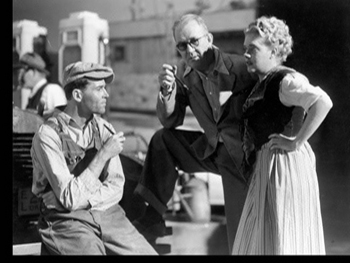
Above John Ford on the set of "The Grapes of Wrath".
Turning John Steinbeck's Novel Into A Screenplay
John Steinbeck gets on-screen credit as the novelist, but the screenplay was written by the previously mentioned co-executive producer Nunnally Johnson. Who also was nominated for the Academy Award for "Best Adapted Screen Play".

Above writer, producer and director Nunnally Johnson in 1939.
Prior to this feature film, among Johnson's screenplays, were the George Arliss, Loretta Young, Boris Karloff and Robert Young 1934 historical feature "The House of Rothchild", 1936's historical "The Prisoner of Shark Island" about Dr. Samuel Mudd. Who made the mistake of treating John Wilkes Booth's injured leg after the assassination of Abraham Lincoln and 1939's "Jesse James" starring Tyrone Power as Jesse and Henry Fonda as Frank James. Among Nunnally Johnson's later work are 1951's "The Desert Fox: The Story of Rommel" starring James Mason, the 1953 musical "How to Marry a Millionaire" starring Marilyn Monroe, Betty Grable and Lauren Bacall and director Robert Aldrich's 1967 World War 2 drama "The Dirty Dozen".
The Main Motion Picture Cast
Henry Fonda portrayed "Tom Joad". Fonda had just starred, as previously mentioned, in both of John Ford directed motion pictures "Young Mr. Lincoln" and "Drums Along the Mohawk". Immediately after this picture the actor would be seen with 3rd billing in 1940's "Lillian Russell" starring Alice Faye and Don Ameche and would star in German-American director Fritz Lang's "The Return of Frank James" also in 1940.

Jane Darwell portrayed "Ma Joad". Among Darwell's work, that went back to 1913, was portraying the Mark Twain's character of "The Widow Douglas" in both the 1930 "Tom Sawyer" starring Jackie Coogan, "Uncle Fester" on television's "The Adams Family", and 1931's "Huckleberry Finn" starring Coogan and Junior Durkin. Jane Darwell was in the 1932 version of Fannie Hurst's "Back Street" starring Irene Dunne, 1935's "Curly Top" and in 1936 both Captain January" and "Poor Little Rich Girl" all three starring Shirley Temple Along with 1939's "Jesse James" and "Gone with the Wind". In 1964, at the age of 84, Jane Darwell portrayed "The Bird Woman" in Walt Disney's "Mary Poppins". Which was her last of 211 roles.

Above Henry Fonda and Jane Darwell.
John Carradine portrayed "Jim Casy". In 1939, the year prior to this feature, Carradine appeared in 9 different on-screen roles. Among those portrayals was the servant "Barrymore" in the Basil Rathbone and Nigel Bruce "The Hound of the Baskervilles", "Bob Ford" in "Jesse James", a role he repeated in "The Return of Frank James, and for director John Ford. John Carradine portrayed "Hatfield" in "Stagecoach" and "Caldwell" in "Drums Along the Mohawk".

Above Henry Fonda and John Carradine.
Charley Grapewin portrayed "Grandpa Joad". Grapewin started acting in 1900 and was "Uncle Henry" in 1939's "The Wizard of Oz" and had 1st billing in John Ford's adaptation of Erskine Caldwell's novel, 1941's "Tobacco Road". He portrayed "Inspector Queen" in a series of motion pictures starring Ralph Bellamy as his son "Ellery Queen".
_13.jpg)
Above Henry Fonda and Charley Grapewin.
Doris Bowden portrayed "Rose of Sharon Joad Rivers". This was her 5th of only 7 motion pictures. Three of which were directed by John Ford. The two others were both in 1939, "Young Mr. Lincoln" and "Drums Along the Mohawk".
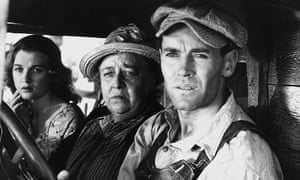
Above Doris Bowden, Jane Darwell and Henry Fonda.
Compared to the novels list of characters the feature film had 35 credited roles and 108 non-credited roles to tell the story.
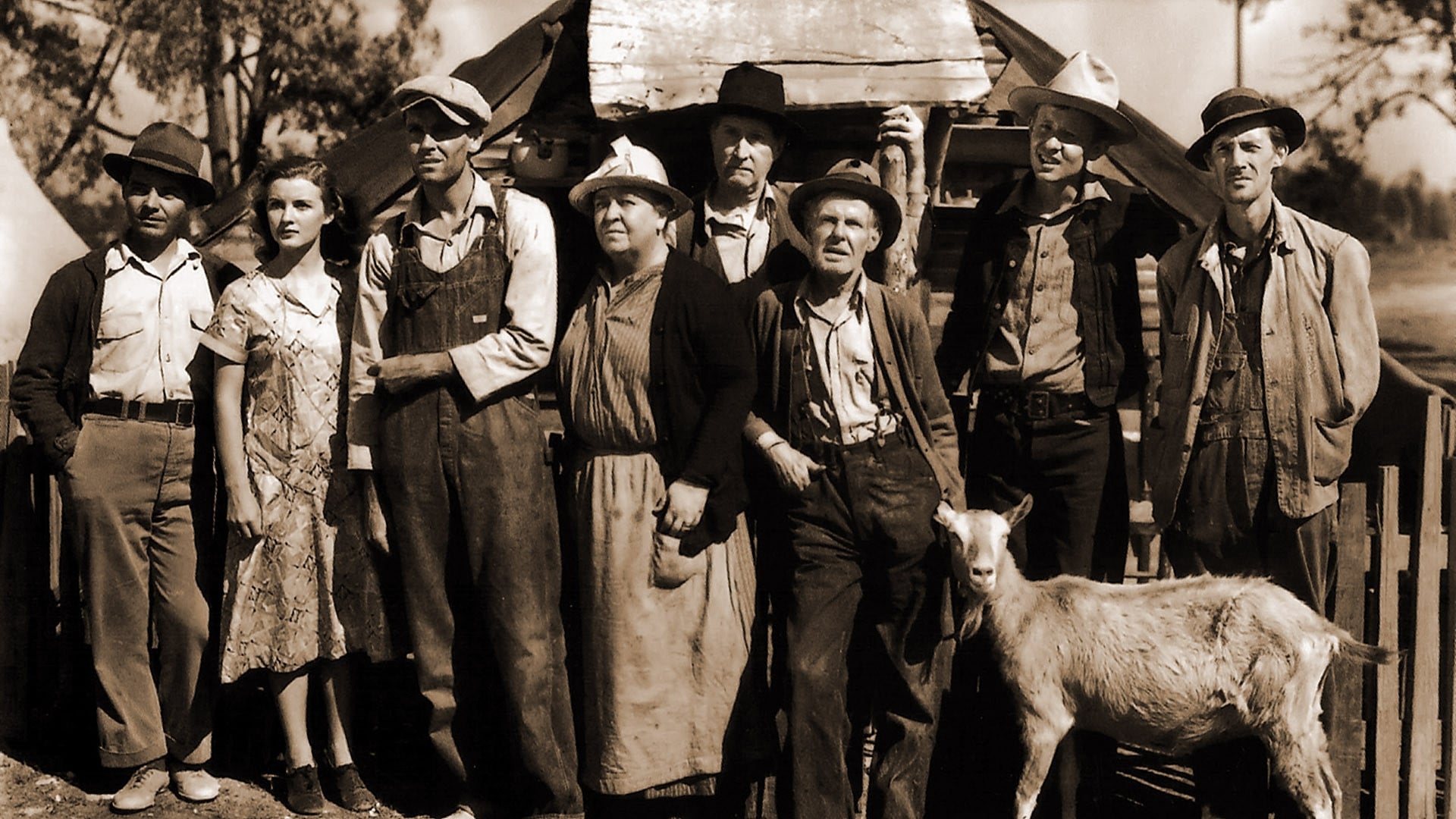
Above "Rose of Sharon" and her husband "Connie Rivers", played by Eddie Quillian, are on the left and on the far right "Jim Casy". Between only some of the "Joad Family".
The screenplay opens exactly like the novel as "Tom Joad" is released from prison and hitchhiking home meets ex-preacher "Jim Casy". Next the two meet "Muley Graves", portrayed by John Qualen. John Ford through the use of a flashback tells how Oklahoma farmers were forced by the banks to loose their homes.

Above John Qualen and Hollis Jewel as "Muley's Son".
Next, "Tom" and "Jim" arrive at "Uncle John's", played by Frank Darien, farm house as everyone is preparing to leave.
The eleven "Joads" plus "Connie Rivers" and "Jim Casy" pack up the converted "1926 Hudson 'Super Six' Sedan" and leave Oklahoma for the promised land of California.

John Ford hired Cinematographer Gregg Toland to capture the look of "Dust Bowl America". Toland had been nominated for the "Best Cinematography"Academy award for director William Wyler's 1939's production of Emily Bronte's "Wuthering Heights". He would receive the same nomination for Orson Welles' 1941 "Citizen Kane". Gregg Toland would finally win his "Oscar" with William Wyler's 1946 "The Best Years of Our Lives".
Gregg Toland used signage, or items with a City or State name on them. To give the audience the feeling that the "Joad's" were actually crossing the United States. Two examples follow:

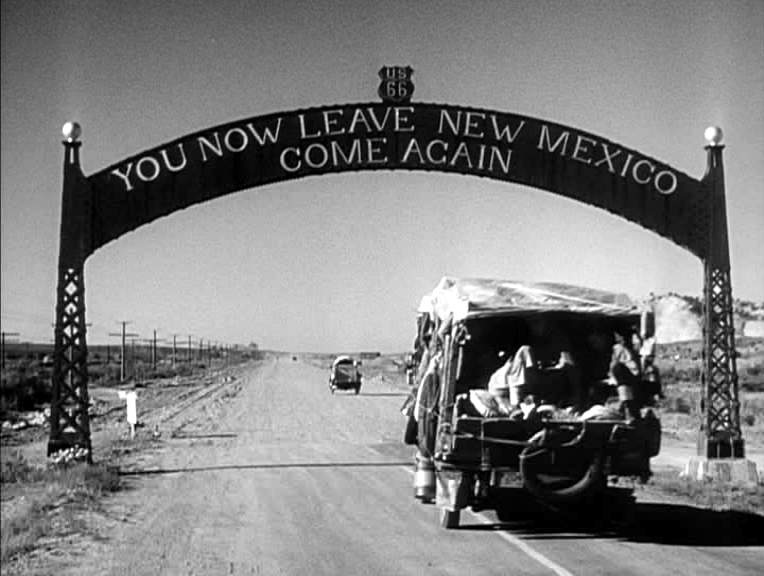
As the family group make their way toward California "Grandpa Joad" passes away. He will be buried by the roadside and "Tom" takes a page from the family bible and writes who he is and the circumstances of "Grandpa's" death. Hoping that, if his body is discovered, someone will know who the man was and not just the body of a derelict that had died upon "Route 66".

Several events and characters in John Steinbeck's novel are dropped from Nunnally Johnson's screenplay at this point. This can be argued from the stand point of either that they detract from the story John Ford wanted to tell, or that Ford and Johnson had to keep the running time down for Daryl F. Zanuck. Even though the finished feature runs two hours and nine minutes.
When the "Joad's" arrive at a "Hooverville" like transit camp. The camp is overflowing with starving, jobless families. The first signs, to them, that things aren't always what they heard life would be like in California. The "Joad's" just keep the truck moving down a dirt road, moving through the shanties and out the other side of the camp. The next day "Tom" notices a sign looking for Orange Pickers.

Their truck enters the "Keene Ranch", and the family makes a second discovery, the high prices of food, clothing and other supplies at the "Company Store". Later, the family learns about a group of migrant workers planning a strike for better working conditions and pay. "Tom" decides to go into the darken woods with "Jim" to the secret meeting.
The meeting is discovered and "Jim Casy" is killed by one of the "Keene Ranch" guards that shows up. "Tom" attempting to defend "Jim" accidentally kills another guard, but has his face cut making him easily identifiable.
The family hides "Tom" under a mattress in the truck as the guards question them. Then they pack-up and at night leave the ranch.
The converted sedan has developed engine problems and is overheating as it comes to the top of a hill.

They decide to coast the truck down the hill towards a large grouping of lights, because they're almost out of gas. This takes the "Joad's" to another camp called "Farm Workers Weed Patch Camp". This turns out to be a clean camp run by "The Department of Agriculture". The camp is immaculate and has indoor showers and toilets. Two things the children have never seen.
"Tom Joad" now becomes the "Every Man" of Steinbeck's novel and Ford's motion picture. He informs the family he plans to carry on "Jim Casy's" work, because of what he has seen traveling to California from Oklahoma.
"Tom" next tells his family and the motion pictures audience:

I'll be all around in the dark. I'll be everywhere. Wherever you can look, wherever there's a fight, so hungry people can eat, I'll be there. Wherever there's a cop beatin' up a guy, I'll be there. I'll be in the way guys yell when they're mad. I'll be in the way kids laugh when they're hungry and they know supper's ready, and when the people are eatin' the stuff they raise and livin' in the houses they build, I'll be there, too.After "Tom" leaves, the family discuss their fears and difficulties of their journey. As they move on the audience hears "Ma Joad" concluding the motion picture saying:
I ain't never gonna be scared no more. I was, though. For a while it looked as though we was beat. Good and beat. Looked like we didn't have nobody in the whole wide world but enemies. Like nobody was friendly no more. Made me feel kinda bad and scared too, like we was lost and nobody cared.... Rich fellas come up and they die, and their kids ain't no good and they die out, but we keep a-coming. We're the people that live.They can't wipe us out, they can't lick us. We'll go on forever, Pa, cos we're the people.FADE OUT!
"Time Magazine" editor Whittaker Chambers wrote a review of John Ford's motion picture for the February 12, 1940 issue. In it Chambers stated:
But people who go to pictures for the sake of seeing pictures will see a great one. For The Grapes of Wrath is possibly the best picture ever made from a so-so book...Camera craft purged the picture of the editorial rash that blotched the Steinbeck book. Cleared of excrescences, the residue is a great human story which made thousands of people, who damned the novel's phony conclusions, read it. It is the saga of an authentic U.S. farming family who lose their land. They wander, they suffer, but they endure. They are never quite defeated, and their survival is itself a triumph.While Vivian Carol Sobchack, an American cinema and media theorist and cultural critic, took the opposite viewpoint in 1979. In her article "The Grapes of Wrath (1940): Thematic Emphasis Through Visual Style" for the "American Quarterly" of "The John Hopkins University Press". Sobchack argued that Ford's motion picture uses visual imagery to focus on the "Joad Family" as a "Family Unit". Compared to Steinbeck's novel which focuses on the journey of the "Joad Family" as part of the "Family of Man". She claims that the motion picture focuses on a specific family rather than the novel focus of man and the land together.
Which viewpoint is the more correct is up to the reader and viewer of both works.
WOODY GUTHRIE
Woodrow Wilson "Woody" Guthrie was born on July 14, 1912 in Okemah, Oklahoma. "Woody' is considered to be one of the most significant composers and singers of what is known as "Western Folk Music". His composition "This Land Is Your Land" is an American Folk Classic.

Woody Guthrie's 1930's recordings published originally in the LP album "Dust Bowl Ballads" are a picture of the migrant farmers, Union Organizers and the Federal Government of the period.
It was while working at Los Angeles radio station KFVD, today Spanish language news and talk radio station KTNQ, that Woody Guthrie met his political mentor newscaster Ed Robbin. Robbin would introduce Guthrie to John Steinbeck and actor Will Geer later of television's "The Walton's". Both lifelong friend Robbin's and Geer would introduce the Folk Singer to the "CPUSA".
The "People's Daily Word" was first published, in San Francisco, by its founder Harrison George in 1938. It was the official successor to the "Daily Worker" a Marxist and American-Leftist publication. George was a senior member of "CPUSA" and was a major United States coordinator of the Communist Party's involvement with American Trade Unions before, during "The Great Depression", and after.
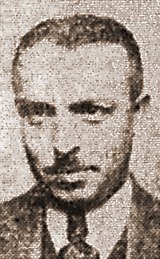
Above a photo of Harrison George in 1930.
Woody Guthrie was never an actual member of the Communist Party, but was a "Fellow-Traveler" in that he believed in the CPUSA's platform toward the American Farm Worker and at times Unions. Guthrie found a means of putting down his thoughts, not necessarily political, and reaching migrant workers like he had been, Union organizers and just plain folk through Harrison George's publication. Between May 1939 and January 1940, Woody Guthrie wrote 174 columns for the "People's Daily Word" under the heading "Woody Sez". Which brings me to the subject matter of this article, "Tom Joad".
Woodrow Wilson Guthrie was one of many people who went to see John Ford's motion picture version of "The Grapes of Wrath". Referring to the "Folk Archive" website:
http://www.folkarchive.de/tomjoad.html
Are these two quotes about the origin of Woody Guthrie's "Dust Bowl Ballad" "Tom Joad" from George Harrison's publication and the column "Woody Sez". The folksy wording was Woody playing with the image people thought an Okie sounded like that he used for the column:
Seen the pitcher last night, Grapes of Wrath, best cussed pitcher I ever seen.
The Grapes of Wrath, you know is about us pullin' out of Oklahoma and Arkansas, and down south, and a driftin' around over state of California, busted, disgusted, down and out, and a lookin' for work.
Shows you how come us to be that a way. Shows the dam bankers men that broke us and the dust that choked us, and comes right out in plain old English and says what to do about it.
It says you got to get together and have some meetins, and stick together, and raise old billy hell till you get youre job, and get your farm back, and your house and your chickens and your groceries and your clothes, and your money back.
Go to see Grapes of Wrath, pardner, go to see it and don't miss.
I wrote this song in New York. It was the night that I saw the moving picture, "The Grapes of Wrath" by John Steinbeck. If I could only think of the name of the friend that lived in that apartment I would sure like to thank you. You are friendly and wine is good. And this is on a Victor record.
The following are the lyrics to the "Ballad of Tom Joad" written and sung by Woody Guthrie:
Tom Joad got out of the old McAlester Pen;
There he got his parole.
After four long years on a man killing charge,
Tom Joad come a-walkin' down the road, poor boy,
Tom Joad come a-walkin' down the road.
Tom Joad, he met a truck driving man;
There he caught him a ride.
He said, "I just got loose from McAlester Pen
On a charge called homicide,
A charge called homicide."
That truck rolled away in a cloud of dust;
Tommy turned his face toward home.
He met Preacher Casey, and they had a little drink,
But they found that his family they was gone,
He found that his family they was gone.
He found his mother's old-fashion shoe,
Found his daddy's hat.
And he found little Muley and Muley said,
"They've been tractored out by the cats,
They've been tractored out by the cats."
Tom Joad walked down to the neighbor's farm,
Found his family.
They took Preacher Casey and loaded in a car,
And his mother said, "We've got to get away."
His mother said, "We've got to get away."
Now, the twelve of the Joads made a mighty heavy load;
But Grandpa Joad did cry.
He picked up a handful of land in his hand,
Said: "I'm stayin' with the farm till I die.
Yes, I'm stayin' with the farm till I die."
They fed him short ribs and coffee and soothing syrup;
And Grandpa Joad did die.
They buried Grandpa Joad by the side of the road,
Grandma on the California side,
They buried Grandma on the California side.
They stood on a mountain and they looked to the west,
And it looked like the promised land.
That bright green valley with a river running through,
There was work for every single hand, they thought,
There was work for every single hand.
The Joads rolled away to the jungle camp,
There they cooked a stew.
And the hungry little kids of the jungle camp
Said: "We'd like to have some, too."
Said: "We'd like to have some, too."
Now a deputy sheriff fired loose at a man,
Shot a woman in the back.
Before he could take his aim again,
Preacher Casey dropped him in his track, poor boy,
Preacher Casey dropped him in his track.
They handcuffed Casey and they took him in jail;
And then he got away.
And he met Tom Joad on the old river bridge,
And these few words he did say, poor boy,
These few words he did say.
"I preached for the Lord a mighty long time,
Preached about the rich and the poor.
Us workin' folkses, all get together,
'Cause we ain't got a chance anymore.
We ain't got a chance anymore."
Now, the deputies come, and Tom and Casey run
To the bridge where the water run down.
But the vigilante thugs hit Casey with a club,
They laid Preacher Casey on the ground, poor Casey,
They laid Preacher Casey on the ground.
Tom Joad, he grabbed that deputy's club,
Hit him over the head.
Tom Joad took flight in the dark rainy night,
And a deputy and a preacher lying dead, two men,
A deputy and a preacher lying dead.
Tom run back where his mother was asleep;
He woke her up out of bed.
An' he kissed goodbye to the mother that he loved,
Said what Preacher Casey said, Tom Joad,
He said what Preacher Casey said.
"Ever'body might be just one big soul,
Well it looks that a-way to me.
Everywhere that you look, in the day or night,
That's where I'm a-gonna be, Ma,
That's where I'm a-gonna be.
Wherever little children are hungry and cry,
Wherever people ain't free.
Wherever men are fightin' for their rights,
That's where I'm a-gonna be, Ma.
That's where I'm a-gonna be."
"Tom Joad", John Steinbeck's "Every Man", faced "The Great Depression" and Republican President Herbert Hoover's lack of concern for millions of American's. The people would vote Hoover out of office and elect Democratic President Franklin Delano Roosevelt and bring on "The New Deal".




No comments:
Post a Comment